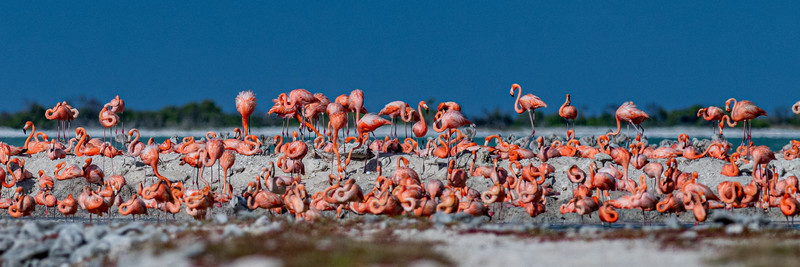Flamingo Rehab
Lorenzo Mittiga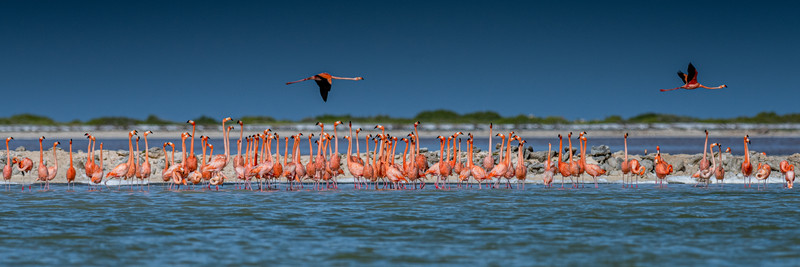
Doing the utmost to help Bonaire’s Flamingos
Elly Albers arrived on the island of Bonaire 32 years ago. After visiting a friend and falling in love with the island, she went back home to Holland and decided to move definitely to Bonaire. She had just completed the psychiatric nurse school, but on Bonaire she started to work at the animal shelter that was in development. She spent 6 years working at the animal shelter where she learned many things about caring animals. Without any experience and without the presence of a resident vet (coming from Curacao only in special occasion), she could only rely on “the manual for vet” at that time. At same time she was also occupied at the animal welfare. Years later she started the mangrove center, organizing kayak’s tours to discover the mangroves. She started the rehab center (2018) when, after the person on the island who was in charge to take care of wild birds passed away, there was the need for somebody to take over the role.
At that time, she had only one cage for birds. In the 2017, after a big oil spill in Trinidad, Stinapa, the Park authority of Bonaire, asked her if she could help to save 10 Brown boobies in trouble. The Park built the first cage to host the 10 seabirds covered by oil. Elly without any experience with birds and risking making many mistakes and without following any procedure for “washing oiled birds”, used only her passion and dedication -she saved, fed and rehabilitated all the birds.
After two months she was ready to release them but she was not sure if the birds would have been waterproof again, so she called the experts in Holland in order to ask the correct procedure to apply. She also described to them what she did and how she recovered them, understanding she could have done even more for them. Fortunately, all the birds survived, but from Holland they sent a trained person with specific water basins in order to train Elly to make the rehabilitated seabirds waterproof in case she would have faced the same problem again. She was taught also on how to tube feed, to check and draw the blood and how to wash and handle correctly any and all kinds of bird.
Everything started from that. A year later, in 2018, a big issue happened (the cause is yet clear) with 450 flamingos brought to the rehab center within 3 months. Elly had to improvise a real rehab center in order to take care of all this birds and feed them with special food and medical supplies. The expenses were huge. The Wild Bird Rehab Center born with no intention but in order to get support from people’s donations, the only way was to start a foundation.
Luckily for the flamingos, the rehab center was opened and running at full power. Since the opening for two years the center rehabilitated more than a thousand flamingos with the help of volunteers under long shifts of work. Elly’s dedication made possible to organize and schedule the work with people coming to help also from the hospital and the emergency room. She needed to train people to tube feeding and make sure that every shift had a trained person in order to do this delicate part of the job.
Luckily, this year (2021), is still quiet and she can handle the center by herself, even with dozens of flamingos and other bird’s species at time. She only asks for help to dedicated and resident volunteers when there are specific tasks to do, like the “releasing”. Her husband, helps her every day for some routine work when four hands are better than two. The good thing is that on Bonaire, there are always people ready and willing to help as volunteers.
Elly says that the major threats for flamingos are the excessive development and the loss of habitat for the birds along with pollution. She remembers, 30 years ago, when only 5000 people were on the island, compare to the 20000 of today, plus the turnover of many cruise ships with other thousands of tourists discharged on the island every week.
Flamingos are very shy birds. Tourists are continuously scaring them by breaking the rules of the park and entering in off-limits just to get a closer picture. The Flamingos are forced to continuously move and change areas as soon one tourist gets too close to them.
There are only a few breeding grounds for this Flamingo’s species including the small island of Bonaire. A Flamingo breeding ground in the area of the salt basins, Is a very restricted area where formally nobody is allowed to enter with an exception of specialized people like Elly and some park rangers, but people still sneak in to do the fishbone fishing or to take photos.
If the breeding grounds are not protected properly the entire colony of Flamingos is in danger of surviving. It is told that many years ago, the royal family from Holland, decided to fly over the flamingo colony with a small plane. The colony was totally scared off and left Bonaire returning back only two years later.
Elly’s routine day with birds starts at 7am by cleaning the cages and feeding the birds. Bonaire Wild Bird Rehab since 2019 is allowed to “band” flamingos which comes into the rehab center with permission from the Netherlands. By doing this, the birds can be tracked, and should it be returned another day, the center will know exactly what the bird’s prior situation was.
Every banded flamingo seen in Bonaire’s natural environment is a successful story of rehabilitation.
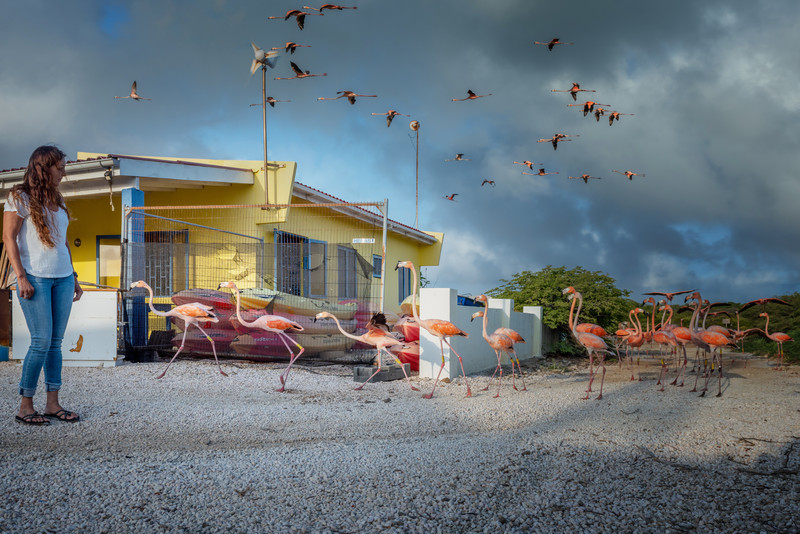
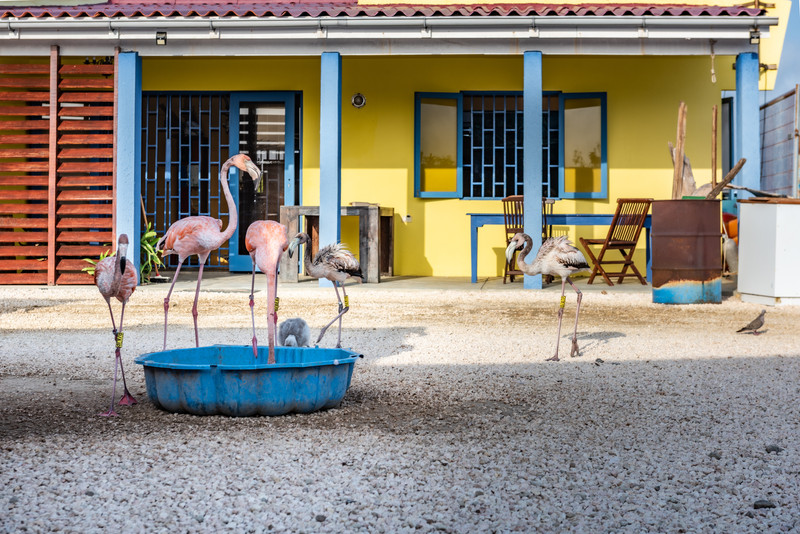
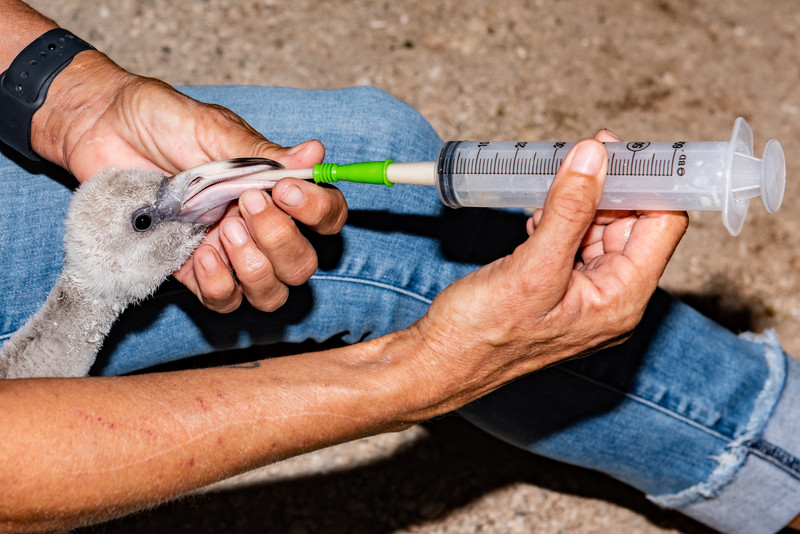
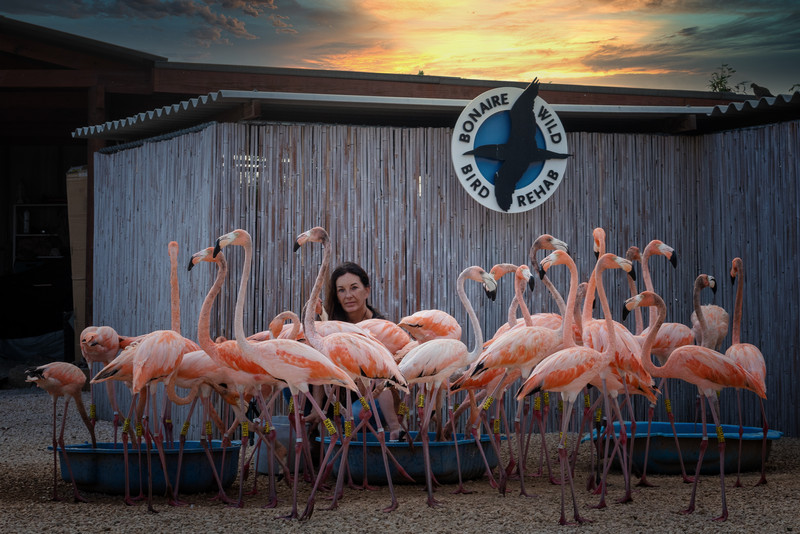

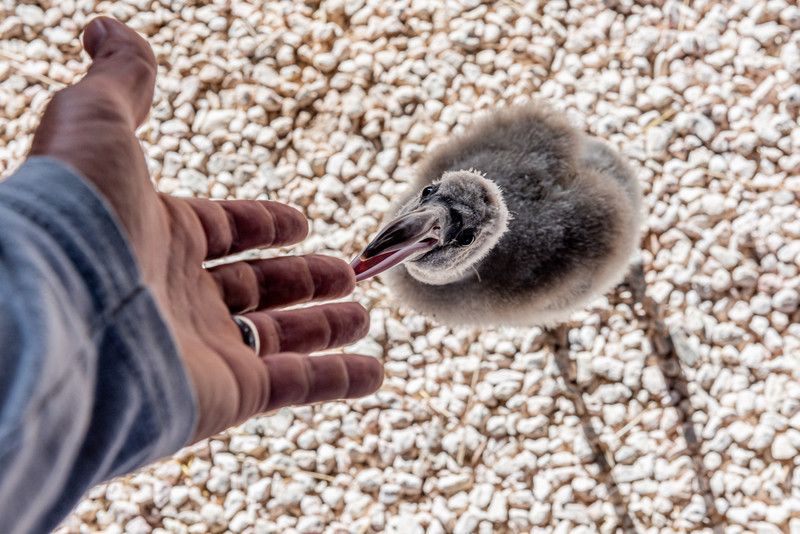
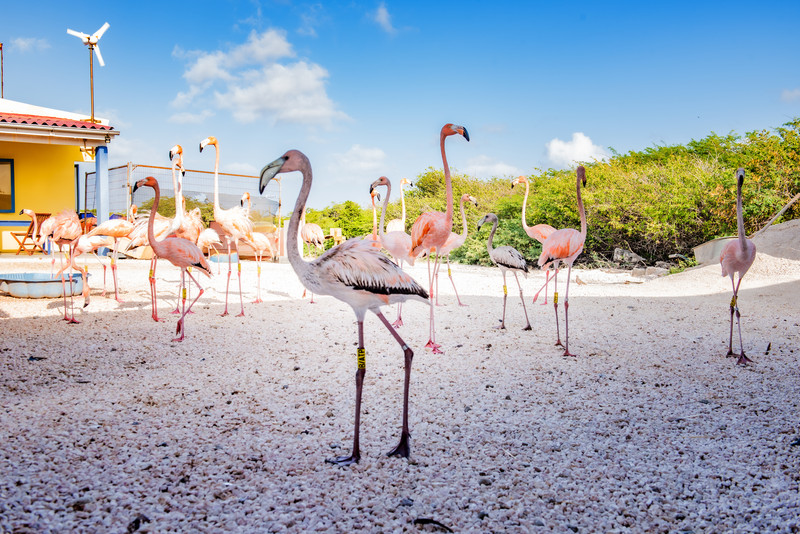

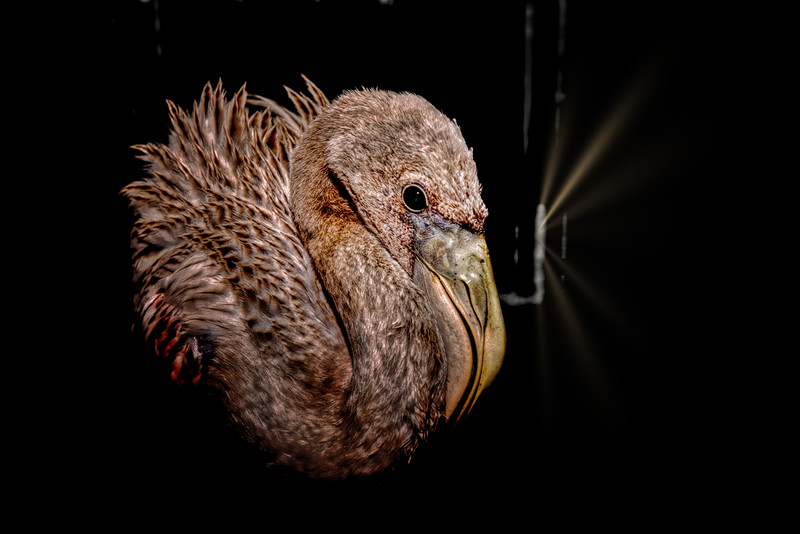
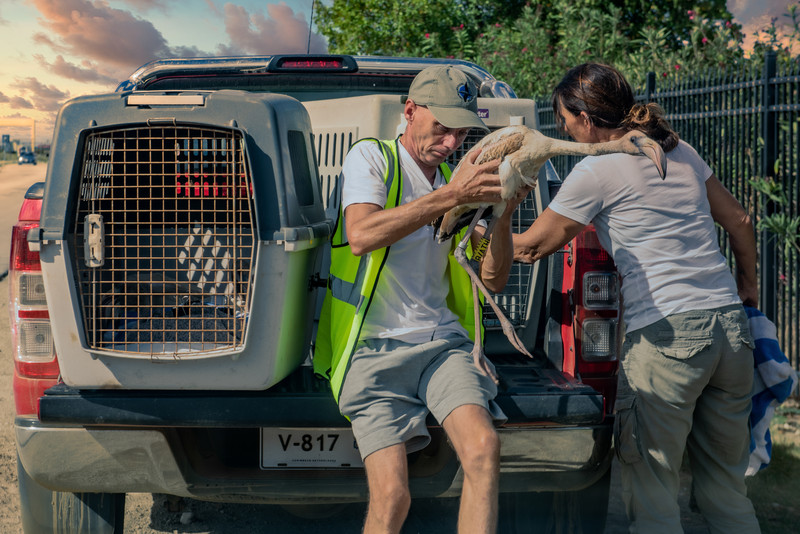

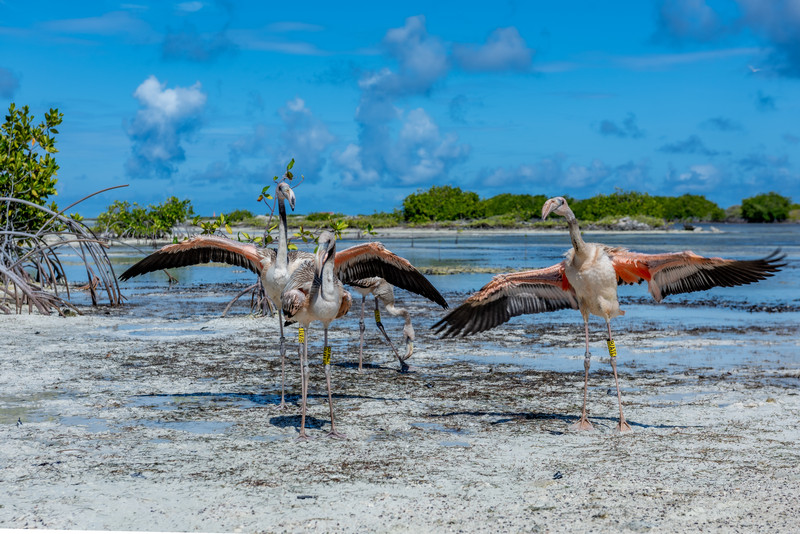
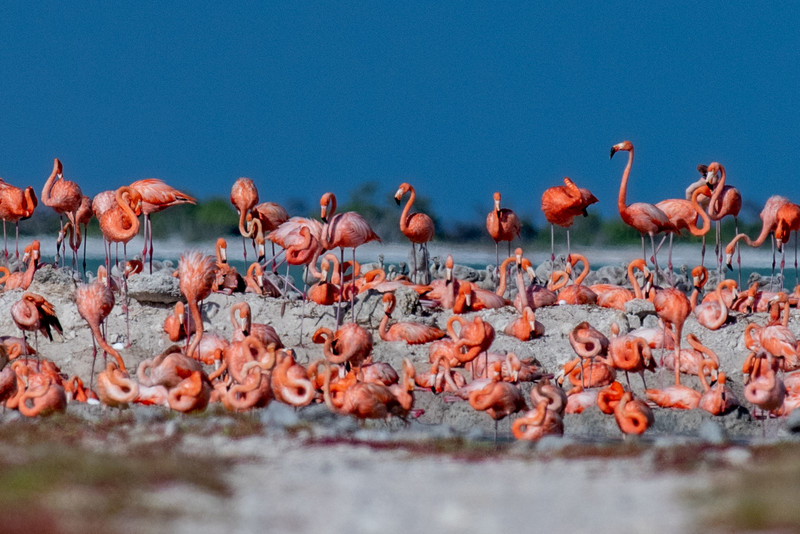
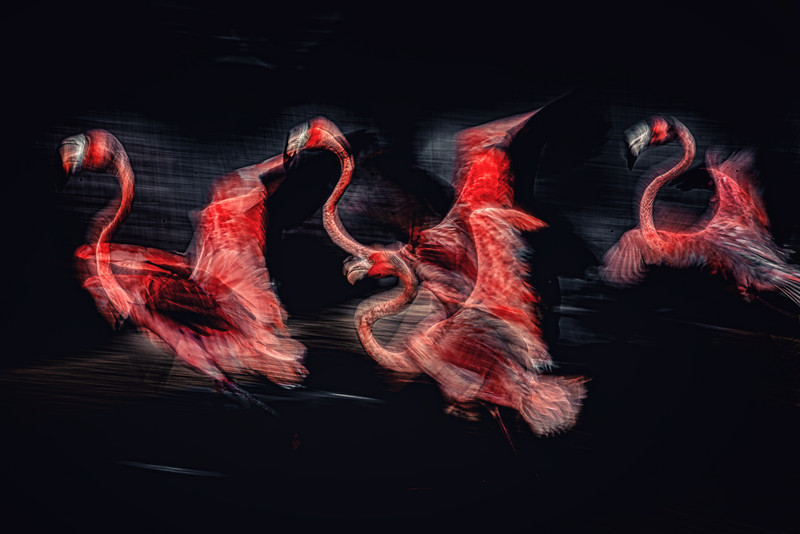
About Flamingos
The Caribbean Flamingo (Phoenicopterus ruber) is well known as American Flamingo. On Bonaire Island, Dutch Caribbean, is called “Chogogo” in the local Papiamento language.
World wise, Bonaire is one of the fourth breeding grounds of the Caribbean Flamingo. This beautiful delicate bird became the island’s icon: even the Bonaire’s airport is named after it “Flamingo International Airport”.
The Flamingo is a least concern species. With different concentration, are spread in various locations of the island as long they are close to the wet lands and brackish water basins.
The adults of this particular species are the largest flamingos in the Americas, compared to the Chilenian species. They can easily reach 145cm in height with a minimum of 120cm and weight between 2.7Kg for the males and 2.2Kg for the females. What is amazing about this unique bird is definitely its life expectancy with 40 years. The color of the plumage, pink or light orange, depends upon the kind of food consumed. The “call” is a goose-like honking.
Flamingos are very important to Bonaire’s ecology, that’s the reason why their population is continuously monitored and counted. In the past, flamingos outnumbered people but today, while the flamingo’s population is stable, the human population increased tremendously in the last decade, giving less space and territories to the birds.
Flamingos my breed up to 3 times a year on Bonaire. However, the main breeding season is march through mid-July.
After the mate is chosen, the pair will build a tower-like nest of mud on the ground, which can reach a diameter of 40cm. The breeding ground becomes very populated at that time, leaving just a little private space between the nests, just to avoid pecks from the neighbours.
The female, after mating, will lay just one egg which is incubated by both parents for 4 weeks. The newborn chick is light grey in color and will remain in the proximity of the nest for 6-8 days, then it will join the other juveniles in what is called “nursery” (large gathering of chicks) under the supervision of the adults. At this stage, the chicks are able to run and swim but not to fly yet and they are fed by adult’s regurgitation.
It’s estimated that ca. 1000 chicks are born on Bonaire every year, but not all of them are strong enough to make it to the adulthood.
Between 2018 and 2021 an extraordinary number of Flamingo chicks were found out of the breeding colony. During the seasons of strong wind, the ultra-lightweight chicks can be blown out of the protected areas. It was found that most of these chicks were underweight and malnourished. After a research was conducted, it came out that the quality of the food in the feeding ground is the cause. It isn’t yet clear if the food is enough or not.
Elly Albers of the Bonaire Wild Bird Rehab assisted Bonaire’s flamingo chicks which were experiencing this life-threatening problem.
Flamingos are filter feeders. They stir up the mud with their feet and with their inverted head upside-down they filter the water. Their bill is specifically shaped and made for filtering-feeding. Inside their bill they have a special sieve that enable them to retain from the filtered water only specific organisms like small brine shrimps, algae, seeds, mollusks, insects and other microscopic organisms that are usually in their diet.
Sometimes flamingos are feeding in a different way acting like “vacuum cleaners” along the shore line sweeping back and forth their heads and hoovering up little brine flies.
Every day or so, at sunset, it might be possible to see small group of flamingos flying heading to Venezuela (ca 80 miles) for better feeding grounds, once sated they come back to Bonaire at sunrise.
click to view the complete set of images in the archive
